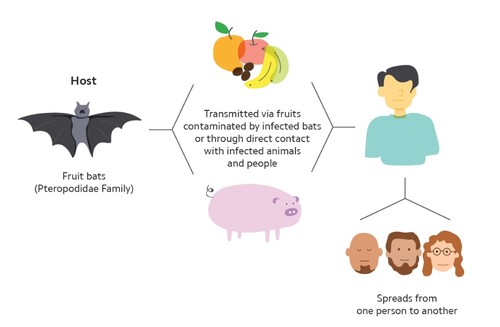The deadly Nipah virus has broken out again in Kerala. The rare virus is transmitted by fruit bats, and those who fall ill have a low chance of survival.
Authorities in the southern Indian state of Kerala are working to contain a new outbreak of the Nipah virus. The state government has demarcated and cordoned off a wide containment zone around where the outbreak happened. Authorities are now trying to locate and isolate the people who came in contact with those infected. People in neighboring regions have been alerted.
The virus is believed to be a variant first discovered in Bangladesh. Humans and animals can infect each other directly through droplets or contact with contaminated surfaces. Human-to-human transmission is also possible.
The infection triggers encephalitis and can lead to mild to severe illness, but also to death. In the variant first discovered in Bangladesh, the mortality rate is very high: one third of patients have died. However, this variant is considered less contagious.
How dramatic is the current outbreak?
To contain a new outbreak of the dangerous Nipah virus, thousands of offices and schools have been closed in Kerala. In Kozhikode district, several containment zones have been established around nine villages.
Two people have already died. Kerala Health Minister Veena George confirmed another case of the Nipah virus on Wednesday, bringing the total number of infections in the state to five. A 24-year-old employee of a private hospital in Kozhikode was diagnosed with the virus, the minister said.
This is the third outbreak of Nipah virus in Kerala in five years. Currently, 706 people are on the contact list, of whom 77 fall into the high-risk category and 153 are health workers.
No one in the high-risk group is currently showing symptoms.
At least 13 people are currently hospitalized for observation and are showing mild symptoms such as headache.
How is the virus transmitted?
Nipah virus is commonly found in fruit bats (Pteropodidae), which feed on nectar and pollen, as opposed to vampire bats which eat insects and drink the blood of animals. Fruit bats are much bigger and use their eyes, and not ultrasound, to orient themselves.
Scientists still don’t conclusively know how the virus is transmitted from fruit bats to pigs, cattle or even humans. However, there are indications that both humans and animals can get infected by coming in contact with the contaminated saliva and urine of fruit bats.
The 2018 outbreak in Kerala was probably due to contamination of a drinking water source. Dead fruit bats were later found in a well belonging to the house of an infected family in Changaroth. First, many of the family members fell ill. Later, their acquaintances also got sick.
Why is the virus so dangerous?
The Nipah virus aggressively inflames the brain. The US Centers for Disease Control cites an incubation period of five days to two weeks.
Initial symptoms resemble those of the flu: fever, nausea and severe headache. Some patients experience respiratory problems. Later, disorientation, dizziness and confusion follow.
Within one to two days, patients can slip into a coma and die. The mortality rate for Nipah disease is 70%.
How can the disease be treated?
There is no vaccination or medication against the Nipah virus — neither for animals, nor for humans. Medications have so far only been able to alleviate the symptoms.
In principle, patients must be immediately isolated and taken to an intensive care unit where vital body functions can be supported.
Contact persons or suspected cases must be quarantined to stop the spread of the infectious disease.
Where does the Nipah virus come from?
Nipah virus was first discovered in 1998 in the Malaysian village of Sungai Nipah. Febrile encephalitis — an illness caused by the virus entering the brain — and, in some cases, severe respiratory infections were observed in 229 individuals.
Men who worked in slaughterhouses were the first to catch the infection. It became apparent that one could contract the disease from animals.
Around the same time, a comparatively mild outbreak of a respiratory infection caused by an unknown pathogen was observed in pigs in Malaysia.
Only later did scientists find that the workers and the pigs had been infected by the same virus. As a precaution, more than 1 million pigs — half the country’s total pig population — were culled in Malaysia.
Since then, infection cases of the highly contagious virus have been spotted only sporadically, for example in Bangladesh in 2001 and 2003, and in Kerala in 2018 and 2021.
Is the Nipah virus threatening a new pandemic?
The latest Nipah outbreak in Kerala is in remote rural area. If a spread or an epidemic in the region can be prevented, a spread of the Nipah virus to other countries and continents and thus a pandemic is very unlikely.






